Out and About in Jerusalem
The Hadassah Tour
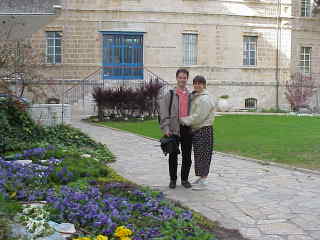 Adam here again. On Sunday, Monica
and I took the Hadassah half-day tour.
Hadassah is a Jewish women's Zionist
organization founded to raise money
and provide assistance to Israel.
Adam here again. On Sunday, Monica
and I took the Hadassah half-day tour.
Hadassah is a Jewish women's Zionist
organization founded to raise money
and provide assistance to Israel.
(An image of us in front of the Hadassah College of Technology is to the left.)
As we learned on the tour, the
organization was founded by 12
young women
who noted how poor the health
conditions in Palestine were
at the time.
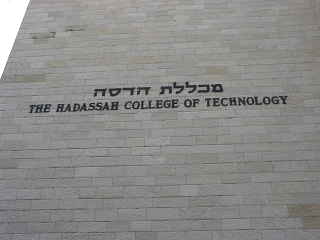 At the beginning, they had just two nurses, and a
donkey who carted medicines around to the poor. Today,
Hadassah is the largest membership association
in the United States (according
to the tour guide, although I think the
Red Cross is actually larger;
maybe she meant the largest Jewish
organization in the U.S.).
At the beginning, they had just two nurses, and a
donkey who carted medicines around to the poor. Today,
Hadassah is the largest membership association
in the United States (according
to the tour guide, although I think the
Red Cross is actually larger;
maybe she meant the largest Jewish
organization in the U.S.).
To the right is the original building for Hadassah in Jerusalem, sold to Hadassah by the Rothschild family for only $1 (with the understanding that they would keep the nameplate on the building).
It is now the
Hadassah technology college, one
of the most respected technical colleges
in the country.
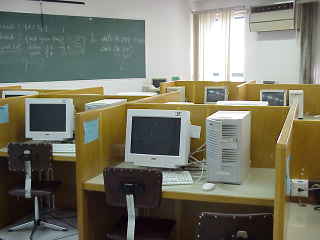 As you can see, the college is highly
technology-oriented, with almost all
programs (including art and
photography) teaching on the computer.
As you can see, the college is highly
technology-oriented, with almost all
programs (including art and
photography) teaching on the computer.
One of the things Monica appreciated about the computer center was
its computer that was outfitted for blind students; it tells people
what they have typed, and even prints in braille. (Monica asked if
there is a different Braille in Hebrew, but apparently there is not;
Braille is a purely English language.)
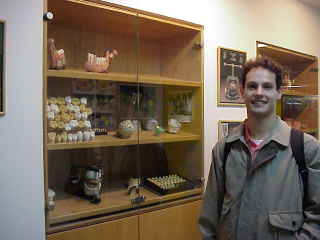 The image to the right is of Adam in front of an exhibit of
the school's dental technology program.
The image to the right is of Adam in front of an exhibit of
the school's dental technology program.
This program teaches students to create prosthetic
devices and use dental examination
equipment.
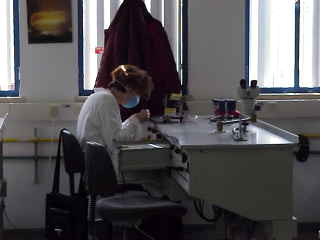 We took the picture above and the one to the left
primarily for Aunt Naomi and Uncle
Irv Eichenbaum (both of whom are dentists).
We took the picture above and the one to the left
primarily for Aunt Naomi and Uncle
Irv Eichenbaum (both of whom are dentists).
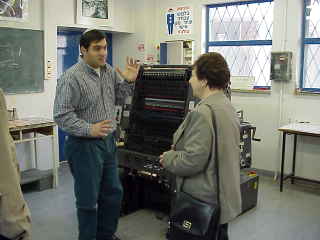 For Monica, as she is a publisher, the school's program in
how to use a printing press was quite interesting.
For Monica, as she is a publisher, the school's program in
how to use a printing press was quite interesting.
Hadassah has a Heidelberg Press printing system for their printing courses. It also has students print publicity and informational brochures as final projects, thus reducing printing costs. Smart thinking!
In the picture to the right, the printer explains to our tour
guide Miriam what he is doing.
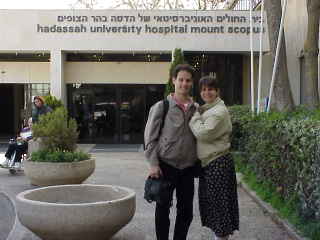 After touring the techology college, we went to the Mt. Scopus
branch of the Hadassah Hospital.
After touring the techology college, we went to the Mt. Scopus
branch of the Hadassah Hospital.
This is the obligatory picture of Monica and me in front of the Mount Scopus Hospital in the hills of Jerusalem.
By the way, for those
of you who don't know, Grandma
Libbie Zucker is among the Redeemers of
Mount Scopus for her charitable
work with Hadassah and her generous gifts.
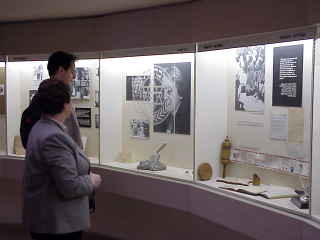 Henrietta Szold was the
founder and guiding force behind
Hadassah. She never married,
instead dedicating her life to improving
Palestine (in those days, it
was hard both to marry and to have a career).
Henrietta Szold was the
founder and guiding force behind
Hadassah. She never married,
instead dedicating her life to improving
Palestine (in those days, it
was hard both to marry and to have a career).
In a room of the hospital,
they have preserved her old desk and
memorabilia from her office. Ms.
Szold unfortunately died before her dream
for the independent state of Israel
could be realized. She passed away in
1945; the country declared its
independence in 1948.
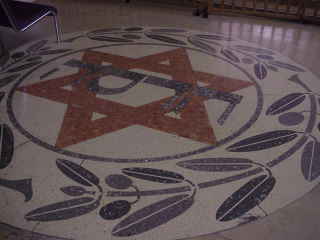 This Hadassah mosaic sits in the center
of the main floor of the hospital.
This Hadassah mosaic sits in the center
of the main floor of the hospital.
When eastern Jerusalem fell to Jordan during the War of Independence, the hospital was more or less destroyed.
When Israel won back Mount Scopus
with the rest of the territories in
1967, the mosaic had "miraculously survived," as our tourguide
Miriam said; it was all that
Hadassah could salvage of the old hospital.
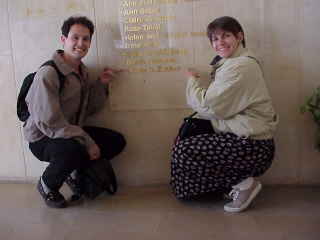 As of last year, Grandma Libbie is also a
Hadassah Founder.
As of last year, Grandma Libbie is also a
Hadassah Founder.
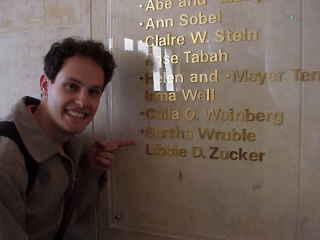 There she is (in the photo to the right/above, and in the photo to the left)
on the wall for posterity.
There she is (in the photo to the right/above, and in the photo to the left)
on the wall for posterity.
We saw some hospital
patients who I am sure are very greatful
for Grandma's support of the hospital.
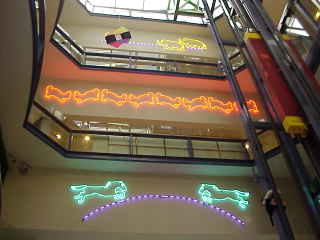 After Mt. Scopus, we were driven to the Ein Kerem
branch of the hospital, which opened in the 1950s after
the Mt. Scopus branch was lost to the Jordanians in the
War of Independence.
After Mt. Scopus, we were driven to the Ein Kerem
branch of the hospital, which opened in the 1950s after
the Mt. Scopus branch was lost to the Jordanians in the
War of Independence.
Originally, the Ein Kerem hospital was some distance outside of the city, but when Ben Gurion allocated the land for it many years ago, he prophetically said, "You build your hospital, and the city will grow to meet it."
He was right and then some.
Since Granny was last here, the
hospital has opened a new chidren's wing.
It has bright, cheerful decorations and
looks a bit like Disneyworld.
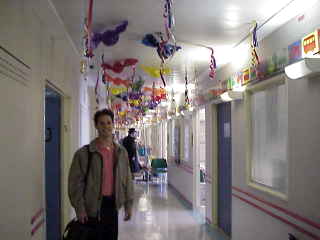 Inside the hallways, the wing was still
decorated for Purim.
Inside the hallways, the wing was still
decorated for Purim.
I'm not sure you can see in the picture, but the decorations hanging from the ceiling are supposed to be candies.
The guide noted
that although all the children are ill,
she rarely hears children crying in the
building.
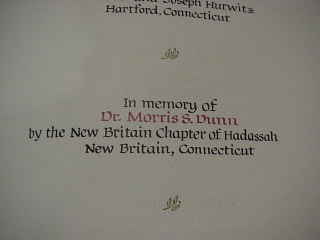 Dr. Morris Dunn (see the Kibbutz section
of the Web page) also has his name
inscribed in the memory book in the
auditorium of the building.
Dr. Morris Dunn (see the Kibbutz section
of the Web page) also has his name
inscribed in the memory book in the
auditorium of the building.
This is the same building in which the famous Chigall windows are installed, but unfortunately we couldn't take pictures in the synagogue. We had a lively tour guide for the windows who went through and explained the symbolism in each one. She got really excited about them.
For those of
you Washingtonians who can't visit Israel
any time soon, you can visit Grandma Libbie
and see her excellent needlepoint
representations of the windows. Of course,
they don't glow like the real thing.
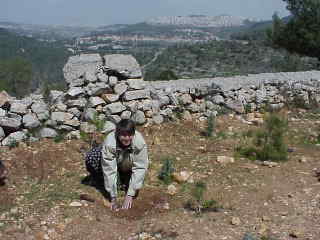 Along with the price of the half-day tour,
we got to plant trees in the Hadassah garden.
This method of donation combined with the
work of many hands turned Israel, once
largely a desert country, into a green and
prosperous land.
Along with the price of the half-day tour,
we got to plant trees in the Hadassah garden.
This method of donation combined with the
work of many hands turned Israel, once
largely a desert country, into a green and
prosperous land.
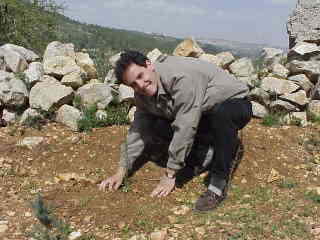 I can see from touching the
soil how hard it must be to make anything
grow here. The soil is extremely dry and
quite rocky.
I can see from touching the
soil how hard it must be to make anything
grow here. The soil is extremely dry and
quite rocky.
The Afternoon
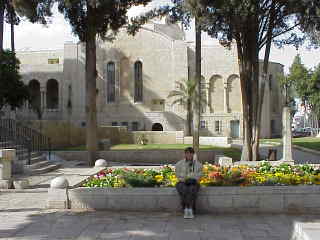 The image to the left is of Monica at the "eemka" (the way Yerushalmis pronounce
YMCA); we went to Le Tsriff at the Y at the recommendation of Susan Ellenberg (we think;
we haven't been able to access Hotmail much lately. Thanks a lot, Bill Gates). The restaurant
in the YMCA was great and the setting highly unusual. The YMCA was apparently built in
the 1930s by Americans to foster peace and brotherhood in Jerusalem.
The image to the left is of Monica at the "eemka" (the way Yerushalmis pronounce
YMCA); we went to Le Tsriff at the Y at the recommendation of Susan Ellenberg (we think;
we haven't been able to access Hotmail much lately. Thanks a lot, Bill Gates). The restaurant
in the YMCA was great and the setting highly unusual. The YMCA was apparently built in
the 1930s by Americans to foster peace and brotherhood in Jerusalem.
The Old City Ramparts Walk
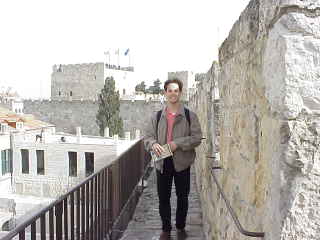 Here Adam stands on the ramparts of the Old City. We took the (shorter than expected)
walk and saw some fairly good overhead views of the city.
Here Adam stands on the ramparts of the Old City. We took the (shorter than expected)
walk and saw some fairly good overhead views of the city.
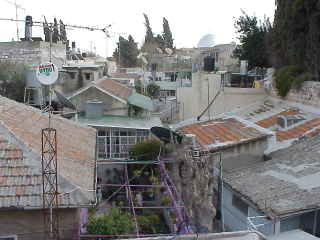 Both of us thought the juxtaposition of ancient holy sites and modern technology was
kind of funny.
Both of us thought the juxtaposition of ancient holy sites and modern technology was
kind of funny.
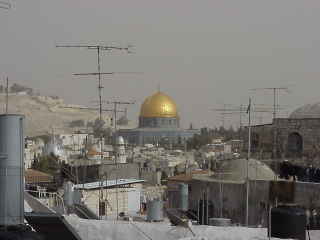 Monica, in particular, was amazed by the interplay between the rooftops. We
both thought that somebody should film an action movie in which the main character is
chased (or chases) over the rooftops of the old city.
Monica, in particular, was amazed by the interplay between the rooftops. We
both thought that somebody should film an action movie in which the main character is
chased (or chases) over the rooftops of the old city.
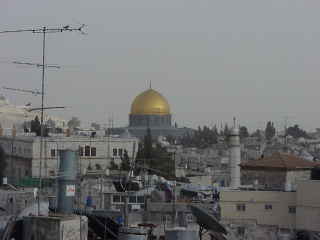 To the left, another shot at the Dome of the Rock (closer up).
To the left, another shot at the Dome of the Rock (closer up).
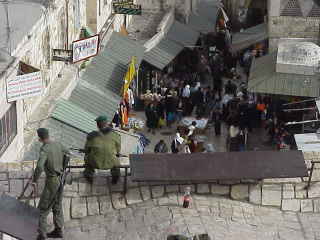 Those of you who have been following our adventures will have noted a shot of the Souk
some time ago in which the IDF (Israel Defense Forces) poised on the ramparts looking over
the scene. Below, you can see the same folks from above. The post is just inside the
Damascus Gate.
Those of you who have been following our adventures will have noted a shot of the Souk
some time ago in which the IDF (Israel Defense Forces) poised on the ramparts looking over
the scene. Below, you can see the same folks from above. The post is just inside the
Damascus Gate.

And here, to the left and below, are two photos of the IDF with the Dome of the Rock in the background.
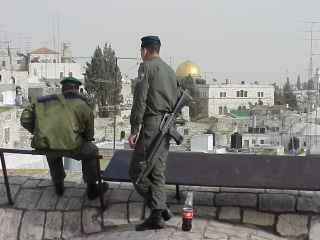 Monica
thought this shot a fitting tribute to the current state of affairs in the Old City--peaceful, but
still a bit tense.
Monica
thought this shot a fitting tribute to the current state of affairs in the Old City--peaceful, but
still a bit tense.
The Hasmonean Tunnel Tour
Adam writes...
Akiva Ilan (whom most of you will remember--in part because of the photo above--was our host in Jerusalem) made reservations for us to take the Kotel Tunnel (also known as the Hasmonean or Herodian Tunnel) tour. Apparently, you have to make reservations in advance because the tours cannot be over-crowded given the enclosed spaces in the tunnel. The Kotel, or Western Wall, apparently once stretched far, far down into what is now the Arab Quarter, so the tunnel is the excavation along that wall.
There was not inconsiderable controversy surrounding the dig. The
Israeli government didn't tell the Arab community about the
dig, and the Arabs thought that the project might undermine
the foundations of the Dome of the Rock, the third holiest site in
Islam. (When the government began giving the tour, the Palestinians
rioted and several people died.) So, the tour was loaded with political feeling from the get-go.
 The archway to the right is at current ground level...actually, several feet
above the exposed base of the Western Wall. It is amazing that
the structure remains so intact after centuries of neglect.
The archway to the right is at current ground level...actually, several feet
above the exposed base of the Western Wall. It is amazing that
the structure remains so intact after centuries of neglect.
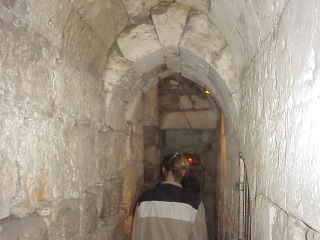 The passageway leads to an exposed area with a large ceiling. This
anteroom is slightly below current ground level.
The passageway leads to an exposed area with a large ceiling. This
anteroom is slightly below current ground level.

Here, we were shown an amazing interactive model of the tour on which we were about to embark. I can't really reconstruct most of the details, but I'll give a shot at what I remember. First, as I mentioned earlier, the wall in the photo is a continuation of the Western Wall, which itself was a part of the outer enclosure of Herod's great temple. We learned that, contrary to popular belief, the Western Wall is not actually part of the Second Temple itself, but rather a part of the retaining wall of the Herodian temple enclosure.
Herod was quite the visionary and had many smart engineers. The retaining
wall of his temple also served as a staging point for bridges that
spanned the walkway along the wall. This design enabled the entries to the
temple mount enclosure to be more restricted. It also solved the problem
of getting water across the bridge to the temple mount area.
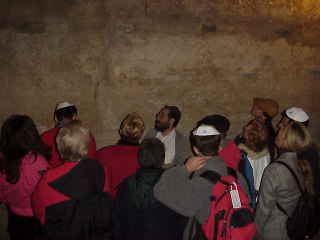
Our fearless guide/leader stands before a tremendous stone that
is actually one huge brick in the Western Wall. I don't remember what
he said it weighs, but it was something like 30 tons.
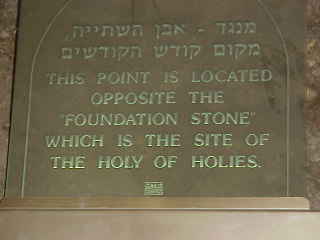 The tour took us along the Western Wall and down toward its base. At
one point, the guide pointed to a spot in the rock. Scholars agree that
this part of the Wall is about 30 feet from the likely resting place
of the Ark of the Covenant, containing the Ten Commandments. (Move
over Indiana Jones... the Holy of Holies was right next to us.) Our
guide said, "Many people take this time to pray, for it is said that,
although G-d listens to prayers anywhere in the world, from here it's a
local call."
The tour took us along the Western Wall and down toward its base. At
one point, the guide pointed to a spot in the rock. Scholars agree that
this part of the Wall is about 30 feet from the likely resting place
of the Ark of the Covenant, containing the Ten Commandments. (Move
over Indiana Jones... the Holy of Holies was right next to us.) Our
guide said, "Many people take this time to pray, for it is said that,
although G-d listens to prayers anywhere in the world, from here it's a
local call."
The reason archaeologists have not been able to dig
further toward the goal of finding the Ark, of course, is because
of the fairly obtuse way the Israeli government went about digging (in
secret instead of with the Arab community's consent). Here our guide
revealed his prejudice (which he did many times with phrases like
"our religious tradition dictates that..."--emphasis added, slightly)
by implying that it was the Arab community's fault that digging was halted
and the passageway cemented shut.
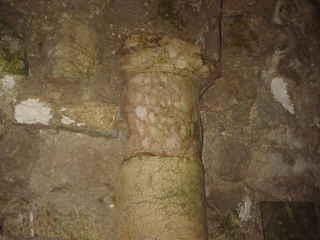
You can't see it very well in this photo, but the dig uncovered the remains of a Roman column on a street that went under an archway...the street spanning Herod's bridges that entered the Temple Mount.
Sorry to say that's all the pictures we took from the tour. It was an unbelievable experience, but like most underground tours, pictures don't do it justice.
One last comment: we exited the tour through an unmarked door that
empties right into the Arab quarter, on the Via Dolorosa. From this point, we were
accompanied by armed security guards. I can understand why--it was a
two-minute walk from the passageway's exit to the entrance to the Temple Mount/Dome of
the Rock. The Arab community must still not be very happy about
the whole project.
 After the tunnel tour, we passed back through the Kotel plaza.
Monica took this beautiful picture of the Western Wall and the Dome of
the Rock together. I think it captures well the grandeur of that acre.
After the tunnel tour, we passed back through the Kotel plaza.
Monica took this beautiful picture of the Western Wall and the Dome of
the Rock together. I think it captures well the grandeur of that acre.
And so ended Day 8 (March 21).
To continue your cybertour, click here.
To go back to the previous page, click here.
To go to the original homepage, click here.
Or to go to the edited homepage, click here.
And, of course, feel free to write to us.
Last updated on July 6, 1999.